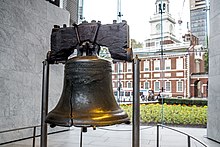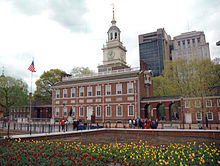Independence Hall
Hamilton and his future son-in-law William Allen, who was later chief justice of the Province of Pennsylvania, were named trustees and were authorized to purchase the land for the proposed state house.
He explained that Kearsley did not approve of his plans for the state house's location and architecture and argued that the assembly had not agreed to these decisions.
The 40-foot-tall (12 m) limestone base was capped with a 14-foot (4.3 m) wooden case surrounding the clock's face, which was carved by cabinetmaker Samuel Harding.
The Lukens clock ran consecutively for eight days, "with four copper dials on each side that measured eight feet in diameter and clockworks that ensured sufficient power to strike the four-thousand pound bell made by John Wilbank."
The steeple had rotted and weakened to a dangerous extent by 1773, but it was not until 1781 that the Assembly had it removed and had the brick tower covered with a hipped roof.
From May 10, 1775,[19] to 1783, the Pennsylvania State House served as the principal meeting place of the Second Continental Congress, a body of representatives from each of the thirteen British North American colonies.
The Congress appointed Benjamin Franklin to be the first Postmaster General of what would later become the United States Post Office Department on July 26.
This document unified the colonies in North America who declared themselves independent of the Kingdom of Great Britain and explained their justifications for doing so.
There are 56 signatures on the Declaration of Independence, including John Hancock who signed first, writing his name in very large letters.
[19] In September 1777, the British Army again arrived to occupy Philadelphia, once again forcing the Continental Congress to abandon the State House.
[19] In September 1786, commissioners from five states met in the Annapolis Convention to discuss adjustments to the Articles of Confederation that would improve commerce.
Twelve states, Rhode Island being the exception, accepted this invitation and sent delegates to convene in June 1787 at Independence Hall.
On September 17, 1787, the Constitution was completed, and took effect on March 4, 1789, when the new Congress met for the first time in New York's Federal Hall.
Article One, Section Eight, of the United States Constitution granted Congress the authority to create a federal district to serve as the national capital.
Following the ratification of the Constitution, the Congress, while meeting in New York, passed the Residence Act of 1790, which established the District of Columbia as the new federal capital.
However, a representative from Pennsylvania, Robert Morris, did manage to convince Congress to return to Philadelphia while the new permanent capital was being built.
It would essentially retrace the 1,654-mile (2,662 km) route Lincoln had traveled as president-elect in 1861 with deletion of Pittsburgh and Cincinnati and the addition of Chicago.
It was carried by hearse past a crowd of 85,000 people and was held in state in the Assembly Room in the east wing of Independence Hall.
The park also holds the Liberty Bell, Franklin's desk, the Syng inkstand, a portrait gallery, gardens, and libraries.
A product of extensive documentary research and archaeology by the federal government, the restoration of Independence Hall and other buildings in the park set standards for other historic preservation and stimulated rejuvenation of old Philadelphia.
[29] As of January 2007, the National Park Service plan was revised to eliminate the fence in favor of movable bollards and chains, and also to remove at least some of the temporary barriers to pedestrians and visitors.
Because of its symbolic history, Independence Hall has been used in more recent times as a venue for speeches and protests[33] in support of democratic and civil rights movements.
National Freedom Day, which commemorates the struggles of African Americans for equality and justice, has been celebrated at Independence Hall since 1942.
The Assembly Room is pictured on the reverse of the U.S. two-dollar bill, from the original painting by John Trumbull entitled Declaration of Independence.
[39] Dozens of structures replicating or loosely inspired by Independence Hall's iconic design have been built elsewhere in the United States, including a brick-by-brick replica across from Knott's Berry Farm in Buena Park, California.








